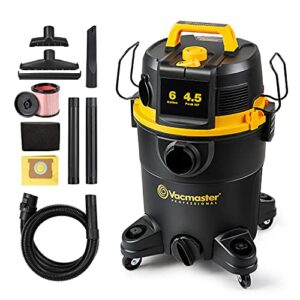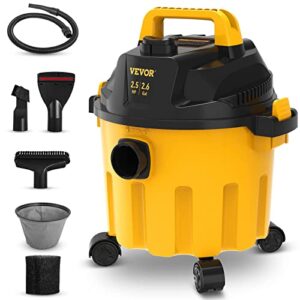Can a Shop Vac Vacuum Water?
Key Takeaways
- Shop vacs can safely vacuum water if properly equipped for wet vacuuming
- Preparations for using a shop vac for water cleanup include removing the bag and filters, attaching a foam sleeve, and using a wet nozzle
- Safety precautions for using a shop vac for water cleanup include using a grounded outlet, avoiding submerging the motor in water, and emptying the shop vac’s tank regularly
Shop vacuums are versatile tools that are commonly used for cleaning up dust, debris, and other messes in workshops, garages, and construction sites. But can they also be used to vacuum water? The answer is yes, shop vacs can safely vacuum water. However, there are a few precautions and steps you need to take to ensure that your shop vac is properly equipped for wet vacuuming. In this article, we will explore the process of using a shop vac for water cleanup, discuss the necessary precautions, and provide some tips for effective wet vacuuming.
Preparing Your Shop Vac for Water Cleanup
Before you can start using your shop vac to clean up water spills, you need to make sure that it is properly prepared. The first step is to remove the bag and filters from your shop vac. These components are designed for dry vacuuming and can get damaged or clogged when used with water. By removing the bag and filters, you create a clear path for the water to flow through the vacuum.
Next, you will need to attach a foam sleeve to your shop vac. A foam sleeve is a special filter that is designed to handle wet messes. It acts as a barrier, preventing the water from reaching the motor and other internal parts of the vacuum. The foam sleeve should be securely attached to the shop vac’s intake port.
Finally, you will need to use a wet nozzle or attachment. A wet nozzle is specifically designed for picking up liquids and is more effective than a regular nozzle for wet vacuuming. It has a wide opening and a squeegee-like feature that helps to efficiently remove water from surfaces.
Tips for Effective Wet Vacuuming
Now that your shop vac is properly prepared for water cleanup, here are some tips to help you achieve the best results:
- Start by removing as much standing water as possible using a mop or towels. This will reduce the amount of water that your shop vac needs to handle.
- Move the wet nozzle slowly and steadily over the wet surface. This will ensure that the vacuum has enough time to pick up the water effectively.
- Avoid submerging the shop vac’s motor or electrical components in water. While shop vacs are designed to handle wet messes, they are not meant to be fully submerged in water.
- Empty the shop vac’s tank regularly to prevent it from overflowing. Depending on the size of the tank and the amount of water you are vacuuming, you may need to empty it multiple times during the cleanup process.
Safety Precautions
While shop vacs are designed to handle wet messes, it is important to follow some safety precautions when using them for water cleanup:
- Always use a grounded GFCI outlet to plug in your shop vac. This will provide protection against electrical shocks.
- Do not use a shop vac with damaged cords or plugs. Inspect the power cord and plug for any signs of wear or damage before using the vacuum.
- Never use a shop vac to pick up flammable or hazardous liquids. Shop vacs are not designed for handling substances like gasoline, solvents, or chemicals.
In conclusion, a shop vac can safely vacuum water if you follow the necessary precautions and properly prepare the vacuum for wet cleanup. By removing the bag and filters, attaching a foam sleeve, and using a wet nozzle, you can effectively clean up water spills and wet messes. However, it is important to use a grounded outlet, avoid submerging the motor in water, and empty the shop vac’s tank regularly. With these precautions in place, a shop vac can be a valuable tool for water cleanup in various settings.
Related Websites:
FAQs:
Q: What is a shop vacuum and what are its primary uses?
A shop vacuum, also known as a wet/dry vacuum, is a versatile cleaning tool designed to handle both wet and dry messes. Its primary uses include cleaning up debris, dust, water, and spills in workshops, garages, construction sites, and other industrial settings.
Q: Can a shop vac vacuum water?
Yes, a shop vac can vacuum water. Unlike regular vacuum cleaners, shop vacuums are specifically designed to handle liquids and solids, making them effective for water cleanup tasks such as removing standing water, spills, and minor flooding.
Q: What is the water vacuuming capacity of shop vacuums?
The water vacuuming capacity of shop vacuums depends on their tank size and water storage capabilities. Different shop vacuums have varying capacities, but on average, they can typically handle several gallons of water before needing to be emptied.
Q: What accessories are needed for vacuuming water with a shop vac?
When vacuuming water with a shop vac, it is recommended to use specialized filters and attachments. These accessories help to improve water suction and prevent damage to the vacuum’s internal components. Additionally, using a separate water collection tank or attachment can make water cleanup easier.
Q: Are there any limitations to using shop vacuums for water vacuuming?
Yes, there are limitations to using shop vacuums for water vacuuming. Shop vacuums may not be suitable for large-scale or extensive water damage situations. It is essential to assess the severity of the water damage and consider professional assistance if needed. Improper water vacuuming can also pose risks, such as electrical hazards or damage to the vacuum.






